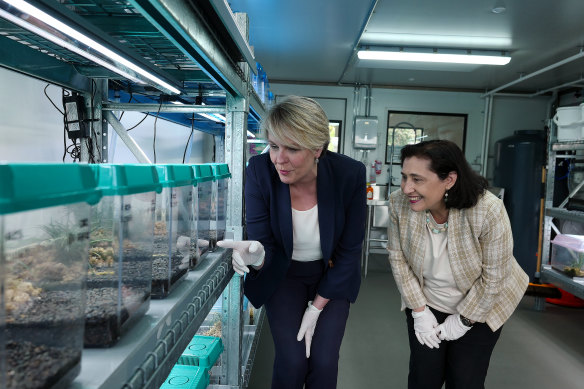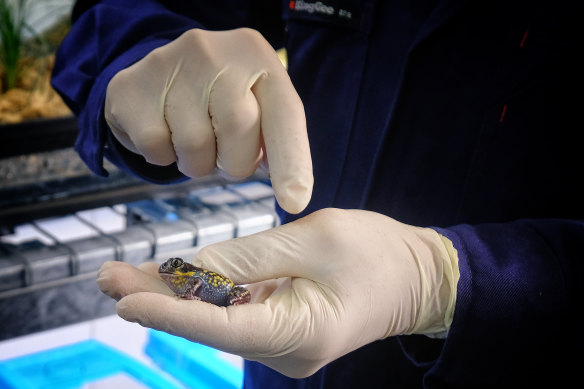
More than 150 southern giant burrowing frogs, reared from tadpoles at the zoo, have already moved into the new facility. These frogs are found in East Gippsland and are one of the rarest and most poorly understood frog species in Australia.

Federal Environment Minister Tanya Plibersek and Victorian Environment Minister Lily D’Ambrosio at the centre on Thursday. Credit:Luis Ascui
The stocky species has powerful muscles in its forearms and hind legs, for burrowing into the earth and crawling across the forest floor, and striking yellow markings on its flanks.
The spotted tree frog, also found in East Gippsland, lives in mountain streams. A smaller species, they are vivid green with bumps all over their skin. The Watson’s tree frog has never been kept in a conservation program before, so the zoo hopes to collect tadpoles and breed them next year.
“We need to have insurance populations because that gives us a base to get individuals back to the wild,” Gilbert said. “That’s what we really want to do, not keep them in a zoo forever.”
Visitors must put on clean shoes and wear gowns when they enter the biosecure facility to prevent the transfer of bacteria or disease to the frogs.

More than 150 southern giant burrowing frogs have already moved into the new facility.Credit:Luis Ascui
Federal Environment Minister Tanya Plibersek and her Victorian counterpart, Lily D’Ambrosio, opened the frog breeding centre on Thursday.
“In recent years, our frogs have had an extremely tough time, fighting the impacts of disease and the devastating impacts of the Black Summer bushfires,” Plibersek said.
The federal government has allocated $200 million to bushfire-affected species, including $1 million to Zoos Victoria that has funded the construction of the Amphibian Bushfire Recovery Centre. The state government said it had spent more than $305 million on Zoos Victoria since 2014.
Loading
Since colonisation, Victoria has lost 18 mammal species, two birds, a snake, three freshwater fish, six invertebrates and 51 plant species to extinction.
Today, between a quarter and a third of all of Victoria’s terrestrial plants, birds, reptiles, amphibians and mammals are considered threatened with extinction, according to the state environment department. This is primarily due to destruction of habitat for housing and agriculture and the invasion of feral species such as cats and foxes.
Get to the heart of what’s happening with climate change and the environment. Our fortnightly Environment newsletter brings you the news, the issues and the solutions. Sign up here.









 Add Category
Add Category